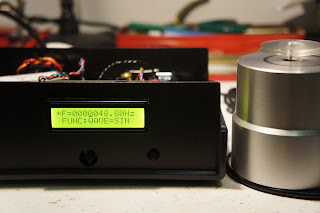My turntable (Acoustic Signature Challenger) came with a 12V ac synchronous motor and outboard power supply. The power supply unit produced a smooth sine wave (in fact : two waves some 90 degrees apart) as confirmed using an oscilloscope. Opening the unit revealed that the timing is by RC circuit and switching in/out different combination of R and/or C to change the frequency to either 50Hz or 66.7Hz (for 33.33rpm or 45rpm platter speeds). Fine tuning of the frequency is by trimming the variable resistors (one trimmer for each speed). Disappointed that the timing circuit wasn't quartz/crystal locked that I expected (RC timing circuits are not known for its accuracy or stability), I decided to build one myself. Searching for sine wave generators led me to DDS (Direct Digital Synthesis) and without having to build one from scratch using a PIC and programming in the codes, I just purchase one from eBay for about USD45. This DDS can output sine, square, triangular waveform up to 2V peak to peak from a few Hz up to 2MHz with 0.01Hz resolution - offering more than what I required. I thought, with 20MHz crystal clock, outputting just 50Hz (a division of some 400,000 times) - its frequency would be highly accurate and stable.
Next step would be to amplify this signal (of about 1V AC sinewave) to the required 12VAC. I just followed this idea : TTPSU and built a class B power amp (5W) using TL072 Op Amp and BD911/912 power transistors, with +/- 18V supply. Connect everything up and put into a plastic box, we have a complete turntable power supply for 12VAC synchronous motor. The 2nd 90 degree out out phase waveform was created using a 4.7uF capacitor (no-polarity). Later, I may add an op amp 'integrator' to derive the cosine wave (90deg) and another set of power amp as an alternative to the capacitor solution. Sine waveform checked with oscilloscope - very fine, distortion not checked. Tested with the motor it works on first try. And with the motor driving the platter, the speed of 33.33rpm was achieved when the frequency is set at 48.90Hz (due to pulley /platter diameter combination and manufacturing tolerances). Satisfaction? You bet.




2 comments:
Hi Chang,
Inspired by you, I just ordered a 2MHz dds from ebay a few minutes ago.I have never built a DIY electrical project except from soldering my headphones, but how hard can it be? My motor is 24V from the Rega p3-24, but I might upgrade to a 110V motor later
I have a few questions though:
The TL072 Op Amp you used, does the version TL072 CP/CN matters? On the opamp should is written 'TL072' only?
The main +-18V supply, did you get that voltage from a already available plug from another electrical device?
Those are enough for a start. More questions will come later. THanks for your help
Hoang.
Hi Chang:
thank you for your sharing.
I want to DIY a turntable power supply as you did for my rega rp3.
however, I am not quite sure the schematics of TL072 and BD912 and BD911.
Could you PM the schematics of this part?
My email address is WSL9378@gmail.com
Best regards
Horace
Post a Comment